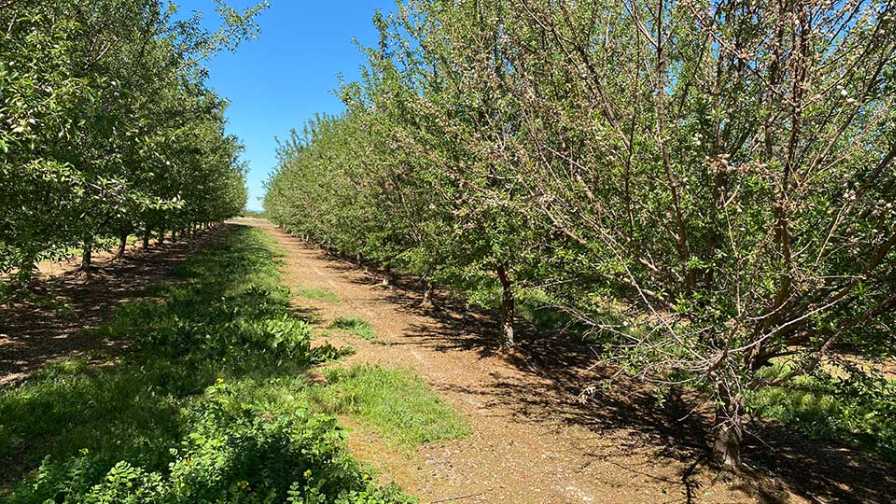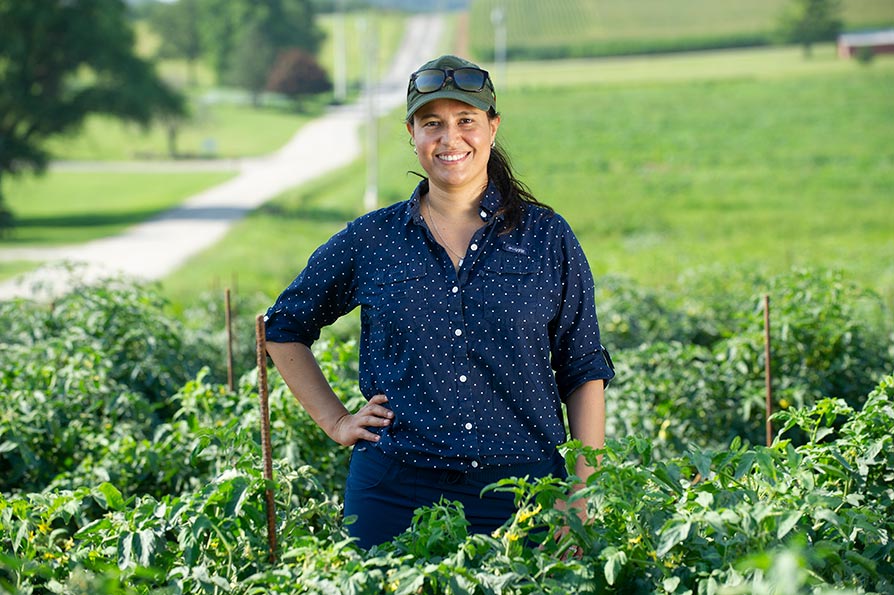Mystery Almond Malady Vexes Researchers

A fifth leaf row of alternating ‘Monterey’ and ‘Nonpareil’ almond trees on Krymsk 86 rootstock in Tehama County, CA. Although the ‘Nonpareil’ trees showed subtle signs of leaf out delay, many of the ‘Monterey’ trees — such as the one in the foreground — showed severe symptoms.
Photo by Luke Milliron
The calls started coming in to University of California farm advisors, specialists, and professors again this year. Luke Milliron, UC Cooperative Extension Farm Advisor for Butte, Glenn, and Tehama counties, says almond growers and Pest Control Advisers (PCAs) have been reporting leaf out issues in several almond varieties, by far most notably in ‘Monterey’. In the case of ‘Monterey’, growers and PCAs started reporting leafing failures in mid-March in the Central Valley on several rootstocks and from several nursery sources.
Reports are mainly in bearing orchards, but farm advisors have seen symptomatic ‘Monterey’ trees as young as second leaf. At least one Northern Sacramento Valley grower with an orchard that should be entering its prime is seeing declining ‘Monterey’ yields after experiencing the issue in multiple years, and the grower now plans to remove all ‘Monterey’ trees — 50% of the orchard. But Milliron notes that although there have been numerous reports of the problem this year, it’s important to note that there are many orchards, including those with ‘Monterey’, that are seeing very little if any of this problem.
In addition, it’s been reported only in orchards in the Sacramento Valley and Northern San Joaquin Valley, which is one reason it’s not believed to be a problem that originates in the nurseries, he says.
“I have not heard of reports south of Madera, nothing even in Fresno, even though there is certainly a lot of ‘Monterey’ there,” he says. “If people (in those areas) do have issues, I hope they contact their UC orchard advisor.”
First Reports
The mysterious problem was first named “leafing failure” two years ago by then-UC Farm Advisor Dani Lightle following several calls she had investigated. This term aptly describes that vegetative buds do not push, at least initially, Milliron says. Other terms that have been used to describe the phenomenon include “pseudo bud failure” and “environmental bud failure.”
In minor cases, growers are seeing leaf out delays on a couple branches, and in severe cases there are no viable vegetative buds, only nuts on several branches. The incidence of affected trees is also highly variable, ranging from a couple of edge trees to a high proportion of ‘Monterey’ in the orchard. Generally, he says if you cut into the bark of affected branches and shoots, the vascular tissue remains green and alive. However, as the season has progressed, there has been some shoot tip dieback visible in some orchards.
Milliron says researchers have historically been unable to pin down a cause for leafing failure because it was a rare event, only being reported periodically in the last couple decades. The problem of leafing failure symptoms was noted periodically before 2000, but most recent reports were made by farm advisors in 2000, 2006, 2010, 2017, 2018, and 2020. In each of these years, farm advisors and specialists attempted to link the leafing failure back to clues in that year’s weather and stress events in orchard history.
One idea mentioned repeatedly by UC-Davis’ Almond Breeder, Tom Gradziel, in the past two decades is a combination of warm winters and a history of severe tree stress, Milliron says, adding that he agrees it’s a combination of many factors. Severe stressors that have been reported by farm advisors include severe water stress during the previous harvest, wet conditions the previous year, acute anthracnose history, defoliation from mites, and trunk bark cankers.
Symptoms have followed many but not all warm winters. According to Milliron, UC-Davis Plant Sciences Professor Maciej Zwieniecki notes that ‘Monterey’ seems to have lower non-structural carbohydrates at the beginning of winter, which may mean lower carbohydrate reserves to use during warm fall and winter conditions that increase respiration. This ‘Monterey’-specific trait can potentially be linked to this variety being most likely to show the symptoms. Dr. Zwieniecki is also planning to investigate if low levels of precipitation may be a factor.
UCCE Almond and Walnut Specialist Bruce Lampinen has long connected wet conditions and leafing failure, Milliron notes. In the case of leafing failure in 2020 and 2018, Lampinen points to wet conditions in the previous spring as being a possible contributing factor. For example, in trial work in the late 1990s and early 2000s, Lampinen and others noted very similar leafing failure symptoms on ‘Monterey’ trees, but only in the wet treatments (averaged -9.9 bars stem water potential) and never in the dry treatments (averaged -12.4 bars). Lampinen’s thinking is that we see leafing failure most predominately in ‘Monterey’ because the variety is particularly susceptible to wet feet in the spring. ‘Monterey’ experiencing wet feet in spring could lead to poor root development and subsequent water stress during summer.
Solutions Elusive
For orchards currently expressing leaf out problems, there is no straightforward solution, Milliron says. “We don’t know what is causing the problem, and the problem has been so intermittent we don’t have much experience to guide us. We do know that not all trees of susceptible varieties show symptoms both within and between orchards,” he says. “This variability may indicate that some management and/or soil conditions may make trees of susceptible varieties more likely to express these symptoms.”
Because researchers don’t know what stressors may be contributing to leafing failure, growers can play it safest by avoiding severe stressors whenever possible, Milliron says. Adopting regular pressure chamber use can help avoid both under- and over-irrigation. There’s a hypothesis being tested in almond, based on success in walnut, that delaying the first irrigation by waiting for mild water stress with the pressure chamber could lead to trees actually being less water stressed late in the season.
“Keep a handle on foliar stresses like mites and anthracnose infections. Work to reduce the risk of bark damage from cankers by protecting pruning wounds and using stream-splitters to keep water off trunks,” he says. “Help avoid shaker damage particularly in young orchards that are especially susceptible to barking.”
Growers who are already seeing these leafing failure symptoms, and have ruled out other causes, should know that removing affected branches now may be premature, Milliron says. Historically, farm advisors reported in many, but not all cases that trees recovered the next year. However, some ‘Monterey’ trees with severe symptoms in 2018 did not recover in 2019, and the problem became more severe in 2020. Vegetative buds may still leaf out later this season, next season, or die but be masked over by new growth elsewhere.
“Flag trees that are showing symptoms and take pictures to track recovery,” he advises. “As we try to get a handle on what’s behind this problem, we need help from growers, orchard managers, and PCAs. Let your local farm advisor know if you’re seeing these leafing failure symptoms and can’t attribute it to other causes.”









